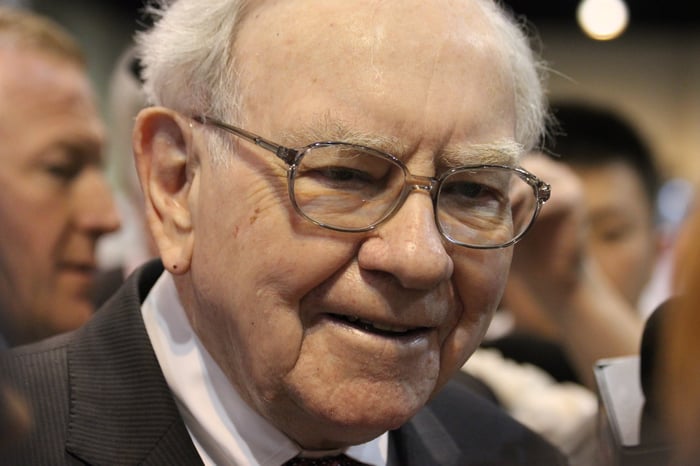When stacked up next to most money managers, Warren Buffett's track record is almost otherworldly. Since taking the helm as CEO of Berkshire Hathaway (BRK.A -0.30%) (BRK.B -0.26%) in 1965, he's overseen the creation of more than $665 billion in market value for shareholders, as well as lapped the benchmark S&P 500 120 times over, with an aggregate return of 3,641,613% for the company's Class A shares (BRK.A) through the end of 2021.
Time has certainly been an ally for the Oracle of Omaha, with patience and his love of dividend-paying companies playing critical roles in his success as an investor. But another key to this success that's often overlooked is Buffett's penchant for portfolio concentration. Even though Berkshire Hathaway holds stakes in around four dozen securities, the lion's share of his investments can be traced to just a few positions.

Berkshire Hathaway CEO Warren Buffett. Image source: The Motley Fool.
This holds true with Warren Buffett's buying activity, too. Since 2016, the Oracle of Omaha and his investment team have put an aggregate of $136 billion to work in just four stocks.
Chevron: $20.9 billion (estimated)
The first stock Warren Buffett has absolutely piled into recently is integrated oil and gas company Chevron (CVX 1.04%). Based on estimated cost basis data from 13F aggregator WhaleWisdom.com, the Oracle of Omaha and his team have spent approximately $20.9 billion buying shares of Chevron since the fourth quarter of 2020.
Though Buffett is known to build Berkshire Hathaway's positions over time, he certainly wouldn't plow $20.9 billion into a single energy stock if he didn't foresee crude oil and natural gas prices remaining elevated. While a domestic recession could weigh on that thesis in the short term, a globally broken energy supply chain would seem to jive with Buffett's likely thesis that energy commodity prices will remain above average for years.
One of the biggest catalysts for higher oil and gas prices is the COVID-19 pandemic. Even though the pandemic caused energy commodity demand to fall off a cliff in 2020, it's the reduced capital investments that followed which will make increasing global supply difficult.
The other factor at work here is Russia's invasion of Ukraine in February. With Europe banning the import of most Russian oil, it sets the stage for possible supply shortages throughout the region this winter and well into 2023. Simple supply-and-demand economics would suggest a tight supply market favors higher prices for oil and natural gas. That's good news for Chevron's drilling segment, which generates its juiciest margins.
As a final note, Chevron is an integrated operator, which means that in addition to drilling and exploration, it operates pipelines, chemical plants, and refineries. These assets help hedge Chevron against energy commodity price weakness.
Apple: $33.3 billion (estimated)
This probably comes as little surprise, but Warren Buffett and his team have been buying shares of tech stock Apple (AAPL 0.52%) hand over fist since the first quarter of 2016. All told, Berkshire Hathaway's cost basis in Apple is an estimated $33.3 billion. Seeing as how this position was worth over $122 billion when the closing bell rang on Dec. 15, 2022, it's safe to say the Oracle of Omaha has done pretty well for himself and his company's shareholders.
In Buffett's most recent letter to shareholders, he described Apple as one of Berkshire Hathaway's "four giants." It's a company that's fueled its sales and profit growth with innovation. Even after more than a decade of smartphone competition, Apple's iPhone is far and away the most popular smartphone in the United States. And let's be clear, it doesn't hurt that Apple's customer base tends to be extremely loyal to the brand.
Even though physical products still account for a majority of Apple's annual sales, subscription services are becoming an increasingly important revenue and profit driver. Steadily transforming Apple into a services provider should lead to higher operating margins over time, as well as lessen the revenue ebbs and flows associated with iPhone replacement/upgrade cycles.
Warren Buffett also absolutely loves Apple's capital return program. Aside from having one of the largest nominal-dollar dividend distributions on the planet among publicly traded companies, Apple has repurchased a whopping $554 billion worth of its own stock in less than 10 years.

Image source: Getty Images.
Occidental Petroleum: $19 billion (estimated)
Chevron isn't the only energy stock the Oracle of Omaha has been piling into over the past couple of years. Warren Buffett and his investment team have spent a cumulative $19 billion building a position in Occidental Petroleum (OXY 0.82%). This includes an estimated $9 billion spent buying more than 194 million shares of Occidental's common stock in 2022, as well as the $10 billion in Occidental preferred stock Berkshire Hathaway purchased in 2019 that yields 8% annually.
Warren Buffett's reasoning for buying into Occidental Petroleum so aggressively is somewhat similar to Chevron -- though there are unique twists. If the global energy supply chain remains challenged for the next couple of years, drillers like Occidental and Chevron will benefit from higher spot prices.
Although Occidental Petroleum is an integrated oil and gas company like Chevron, more of its revenue is skewed toward its drilling operations. While its downstream assets do help hedge against a downturn in crude oil prices, what Occidental really provides Berkshire Hathaway with is an opportunity for significantly higher operating cash flow if oil prices remain elevated.
The other interesting thing about Occidental Petroleum is its balance sheet. Normally, Warren Buffett avoids businesses that are constrained by large debt loads. But this hasn't been the case with Occidental, which has been buried by debt since acquiring Anadarko Petroleum in 2019. With crude oil well above its historical average, Occidental has been able to reduce its net debt from $35.4 billion to $20.5 billion in 15 months (ended Sept. 30, 2022), as well as reinstate a share buyback program.
Berkshire Hathaway: $63.1 billion
However, the stock Warren Buffett has spent the most buying since 2016 began is none other than his own company, Berkshire Hathaway.
Prior to mid-July 2018, Warren Buffett and executive vice chairman Charlie Munger had their hands tied with regard to share buybacks. The only way to repurchase shares of Berkshire stock is if they fell to or below 120% of book value. But at no point in the previous half-decade did that happen, which led to no opportunity for share buybacks.
In mid-July 2018, Berkshire Hathaway's board changed the parameters outlining share buybacks to give Buffett and Munger more liberty to take action. As long as the company has at least $30 billion in cash and U.S. Treasuries on its balance sheet, and both Buffett and Munger agree the company is trading below its intrinsic value, share repurchases can continue without any ceiling. In a little over four years, Buffett and Munger have overseen a jaw-dropping $63.1 billion in Berkshire Hathaway share buybacks.
For a company like Berkshire Hathaway that steadily grows its net income over time, reducing its outstanding share count via buybacks can provide a boost to earnings per share and make the company's stock more fundamentally attractive to investors.
Putting more than $63 billion to work via buybacks is also a testament to Warren Buffett's willingness to bet on himself and the long-term ethos he's created at Berkshire Hathaway over nearly six decades. With an investment portfolio that's packed with cyclical businesses, patience very much favors Buffett's approach.





